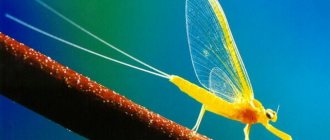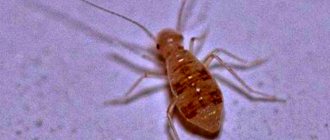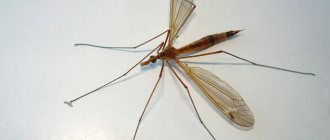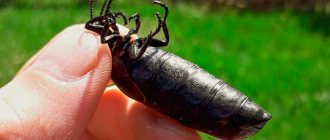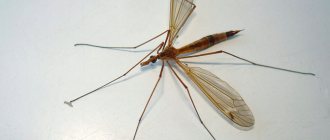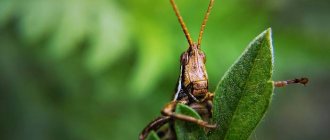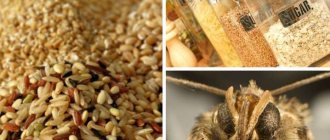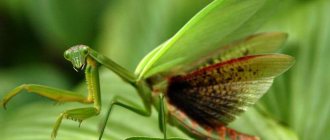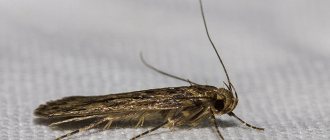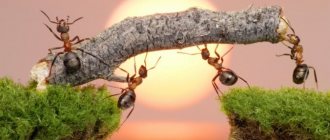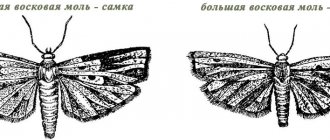Description
Characteristic features of mayflies are three (less often two) thin long tail filaments at the end of the abdomen. The mass emergence of mayflies occurs in mid-summer in the evening and lasts only a few days. The flying mayfly literally fills the entire air space above the river and falls into the water like snow flakes, which is why its second name comes from the snowstorm.
Mayfly larva, or “granny,” is also a good bait. The larvae live in the clayey soil of the underwater shore or in dense tangles of underwater plants. The larvae are whitish in color, have two antennae in front and three fleecy tails in the back.
The mayfly order is divided into several families:
- Family BAETIDS (Baetidae)
. Representatives of the family live mainly in stagnant bodies of water and are characterized by legs pointing to the sides. - Family HEPTAGENIIA (Heptageniidae)
. The larvae have a moderately elongated body, flattened in the dorsoventral direction. Their legs are long, tenacious, their tail filaments are long - these larvae deftly crawl among stones and underwater plants. - Family Mayflies (Oligoneuridae)
. The larvae are distinguished by their large size and compressed body, and their tail filaments are short, shorter than the length of the body. - Family TRUE MAYFLY (Ephemeridae)
. Their larvae have an elongated cylindrical body with strong burrowing legs. These larvae dig tunnels in the clayey soil of slow-flowing rivers. - Family PROSOPISTOMIDS (Prosopistomidae)
. The larvae of this family are distinguished by a very wide, leaf-shaped, compressed body; their gills are hidden under the lateral processes of fused segments, so that they form a gill cavity. The tail appendages of these larvae resemble the fork of lower crustaceans. These larvae live in fast streams under stones.
There are about 2,000 species of mayflies known in the world. About 250 species have been recorded in Russia, about 100 of them are found in the European part. Our most common mayflies belong to the families Double-tailed, Thin-skinned, Seven-day and True mayflies. The most numerous and smallest are two-tailed mayflies. And the largest Russian species is the common mayfly, 15–20 mm long, with brown wings.
Mayflies: some facts
There are amazing butterflies in the world - mayflies. This order includes more than 3,000 species of insects. In each of them, a one-day butterfly lives no more than a day, during which it manages to be born, leave offspring and die.
And their appearance is somewhat non-standard. A distinctive feature of most butterflies are light translucent wings and 2-3 long tail filaments.
Mayflies do not need to be distracted by searching for food. They simply do not have a normal mouth opening, and their digestive organs are filled with air.
Typically, the process of degeneration of a larva into a butterfly occurs simultaneously for many hundreds of insects. And they all go on their first flight together, where they split into pairs.
From a distance, the mating games of ephemerals look like a swarm of flying multi-colored snow over the water; up close, they look like a dance. First, the females flutter upward, hover for a few seconds (at the same time the males fly up to them) and smoothly glide downwards, then all elements of the dance are repeated again.
The purpose of the males after the “dance” is fulfilled. Most of them die right in the air and fall into the water to the delight of the fish, the rest will last another hour or two.
Female mayflies scatter across the territory of a river or lake to lay eggs. And by evening, their life also ends. One butterfly lays about 10,000 eggs. But out of this huge number, no more than a tenth of the total offspring is born. Most eggs and larvae are eaten by fish.
By the way, experienced fishermen who know about such gastronomic preferences of fish get good catches using mayfly larvae as bait. The offspring of mayflies differ from other inhabitants of the reservoir by the presence of ready-made tail filaments and tracheal gills.
The larvae themselves, unlike the butterflies, are nothing remarkable. They are extremely voracious, grow actively and can molt about twenty times during their larval life. At the same time, they live for 2-3 years, as if in compensation for the short life of adults.
When the time comes to transform into a butterfly, so many gases accumulate inside the mayfly larva that the outer shell swells, floats and cracks. And the newborn butterfly clings to the remains of the shell and dries out.
Then the last molt of the insect occurs. The skin on the back of the day-old is torn and the butterfly flies up to perform its first and last dance. Mayflies are the only order of insects in which externally formed butterflies with wings can molt.
Despite the fact that mayfly offspring are left completely unattended, their number and distribution do not decrease. So far, these amazing insects have not been found only in the Hawaiian Islands and St. Helena Island.
Finding and catching mayflies
To wash the larvae, it is most convenient to use a special scoop made of steel mesh with a cell diameter of up to 5 mm and a volume of up to 4 liters. It is attached to a long pole, and if the shore and water allow, then it can be done without a pole. When there is heavy spring water, a rinsing bucket made of mesh, like those used by bloodworms, is indispensable. They throw him into the water on a strong rope and begin to drag him to the shore with short jerks. At first the bucket slides along the bottom, but after a couple of jerks it sinks into the silt, and you slowly pull it towards you. You can tell by the heaviness that the bucket is full, then you can safely pull it out of the water. The contents are washed in it, then the remainder is poured out and the nymphs are selected. You can take an ordinary metal bucket and do everything exactly the same. After you pull it ashore, dump out the contents and disassemble it, moistening it with water. On large rivers it is absolutely impossible to do without a bucket, since the larva is located at a distance from the banks, at a depth of 1.5 to 4 m.
Mayfly for catching
The mayfly fly (an escaped specimen) and its larva are used as bait for fishing.
The first one is collected during the emergence period; roach, bream, ide, and chub bite well on it. It does not last long, dries out quickly and crumbles. You can slow down its deterioration by placing it in the refrigerator.
Small hooks are used to catch insects. Place two mayfly flies and pass the sting through the breast.
Dead mayflies are also used for fishing, but only as an additive to bait.
Mayflies and their larvae: lifestyle features
Mayflies are small insects that live near bodies of water and have an elongated body with thin transparent mesh wings and two or three tail filaments. There are over three thousand varieties around the world.
Mayfly larvae, unlike adults, live only in water, so they have tracheal-branch breathing. The shape of the gills, which extract dissolved oxygen from the water, resembles thin round plates, sometimes covered with fringe. They are located on both sides of the abdomen, and in some representatives of other groups the tracheal gills are located on other parts of the body. For example, in the stonefly they are located on the ventral surface and chest, and in the Jolia larva on the abdomen and head.
One mayfly larva has seven pairs of tracheal gills, six of which are in continuous movement, which can be seen with the naked eye, and one remains motionless. Thus, they create a flow of water to obtain a new portion of oxygen. The frequency of movement depends on the oxygen saturation of the water. If it is not enough, the movements become more frequent and sharper.
Mayflies (Ephemeroptera).
The respiratory system of dragonflies is somewhat different from mayfly larvae. And it's about the intestinal gills. The intestine, like a water pump, draws in and pushes out water, creating respiration. In addition, this process helps them in movement.
A winged specimen of a mayfly.
The lifespan of mayfly larvae ranges from two to three years. During her life, she sheds her old skin and puts on a new one up to thirty times, thereby gradually changing her appearance. The diet of the larvae is very varied. They can consume both plant substances and small insects and even weakened ones of their own kind. Not infrequently, the larvae themselves turn out to be food for other insects, fish and amphibians. Dragonfly larvae often like to eat them. Thanks to their brownish color, they camouflage themselves at the bottom of reservoirs and suddenly attack prey that approaches closely.
Mayfly larvae develop in water.
The body of a mature mayfly does not require nutrition, because its mouth parts are not at all developed. And instead of intestines, she has a solid air bubble, which helps her flutter in the air with ease. Unlike larvae, the life of an adult mayfly is very short. Just a few hours is enough for the mayfly to perform the “mating dance” and lay offspring. On a summer evening, when the sun leaves the sky near a pond, you can watch this fascinating dance of “birth and death.”
Mayfly-Insect Development Stages
In today’s article I wanted to talk a little about entomology, but more precisely about what a fly fisherman needs to know about the insects that live in the area in which he is going to fish.
Many of you will say why do I need this, all the flies that imitate insects are already known, you can just take the right fly and go fishing. Unfortunately, if you don’t know or understand what the fish is currently feeding on and what insect it prefers now, your fishing may not be successful.
A fly fisherman certainly doesn't have to become an entomologist, but you do need to acquire a basic knowledge of insects.
First, let's look at what stages of development insects have; these stages are usually called metamorphosis or transformation.
As can be seen from the above diagram, the insects that we will talk about have different stages of development, and each stage has a different duration. The form of an insect at the stages of transformation is very different from adult insects in appearance. This fact applies more to insects with a full cycle of transformation, for example: butterflies, beetles, caddis flies, and flies.
Insects that do not have a complete transformation cycle are characterized by the fact that one form gradually transforms into another. The larvae, hatched from eggs, sometimes similar and sometimes different from the adult insect, do not pupate, but only molt.
After each new molt, the larva becomes more and more similar to an adult insect. It is these larvae that are of greatest interest to fly fishermen and are called nymphs or naiads.
Imitation of the mayfly nymph has become widespread among fly fishermen. Today we will talk about this insect.
Mayflies (Latin: Ephemeroptera) which means one-day or lasting no more than a day. At the moment, there are more than three thousand species of mayflies, which are distributed throughout the world with rare exceptions. Some of the diversity of these insects lives on the territory of Russia. Of course, I won’t list them; no one will remember anyway, and there’s no point in doing so. The main thing for you is to find out what specific species lives in the area where you are going to fish.
In the future I will talk about mayflies as a general average insect. As I already said, mayflies are insects with incomplete metamorphosis, and the first stage is the egg, which interests us little since it is not food for fish.
But we are especially interested in nymphs (larvae). First, let's look at the general characteristics of all mayfly nymphs.
Nymph Ephemeroptera
The mayfly larva has a length of 6-30 mm excluding the tail, a relatively long abdomen and a short chest with wing rudiments. The nymph also has a clearly defined head with large eyes. The abdomen consists of 10 segments on the sides of which there are tracheal gills - tergalia.
The legs of the larva are well developed and are able to press against the body; due to this, the larva swims very well, making wave-like movements with its abdomen and using its tail as a horizontal fin.
The ability to swim, moving the abdomen up and down, and not left and right, is a distinctive feature of mayfly larvae from dragonfly larvae and stonefly larvae.
Mayfly larvae actively feed, unlike the imago and subimago stages, which do not feed at all. The larvae feed on organic debris and small algae; some species are predators and feed on ciliates and other small animals.
Mayfly larvae are an indicator of clean water and are very sensitive to the presence of chemical compounds in water.
According to their lifestyle, all mayfly larvae are divided into four types:
- FREE-FLOATING Nymphs (swimming nymphs)
They live mainly in calm waters between vegetation. They have an elongated cylindrical body and are able to swim well. The head is small, there may be two or three tail appendages. The size of the larvae is from 6 to 20 mm. Almost the entire group of this type is present in Russia.
- burrowing or burrowing nymphs
They live in stagnant or weakly flowing waters, with sandy and silty soil. They live in burrows dug in the ground and spend almost their entire lives in these burrows. Such nymphs have massive jaws and powerful legs, with which they dig the soil. They have three tail appendages. Sizes from 8 to 30 mm. This group includes “True Mayflies” (Ephemeridae), “Coastal Mayflies” (Polymitarcyidae), “River Mayflies” (Potamantidae). All three families are represented in Russia.
- Clinging or sticking nymphs (dinger)
They live in fast-flowing waters. The body is flat and not as long as that of previous nymphs. Adapted to cling to rocks in fast flowing water. There are three caudal appendages. Body length is from 6 to 16 mm. This group includes mayflies of the family “Seven-day mayflies” (Heptagem'idea).
- Crawler nymphs
They most often live in weakly flowing or standing waters. Such nymphs do not swim, but crawl through algae or sit on rocks. But such larvae are still similar to free-swimming nymphs. The body of such a larva is less elongated relative to actively swimming larvae. There are three caudal appendages. The length of the larvae is from 6 to 16 mm.
While on a body of water, it is advisable for a fly fisherman to determine whether a larva belongs to one group or another. The older the larva, the easier it is to determine its identity. The age of the larvae can be determined by the color of the wing primordia; in adult larvae ready for transformation into subimago, the wing primordia are dark.
Depending on the type of mayfly, their larvae can live in water from one to three or four years. During this time, the larva can molt up to 25 times. And so, when the time comes, the larva rushes upward, to the surface of the water, onto coastal plants or stones, to molt for the last time and turn into a subimago. At the moment, the larvae are especially vulnerable.
Flies that imitate this stage of insect development are called emergers. This is a purely fly fishing term and you will not find such a name in entomology. Flies of this type are very catchy at a certain moment.
Some larvae, having reached the surface of the water, die without throwing off the chitinous layer, and are carried away by the current of water. Such dead larvae also attract fish and, accordingly, there are flies that imitate such dead larvae.
The subimago stage of the mayfly has the English name Dun. Accordingly, the names of flies that imitate this stage contain this word, for example, Olive Dun, Sparkle Dun.
Sometimes this name is also found in imitation of the imago stage, this is due to the fact that the imago and subimago sometimes do not differ much in external characteristics. The subimago is an immature mayfly that can often fly as an adult.
The lifespan of adult mayflies ranges from several hours to ten days, depending on the species. The emergence of adult mayflies usually occurs en masse, and after mating, the males die immediately, and the females rush to the water to lay eggs.
It is worth noting that the emergence of mayflies does not always occur en masse and may not be noticed. Not numerous, that is, the rare emergence of single mayflies is of little interest to the fish.
That's all for now, I did not describe in great detail each stage of mayfly development, but simply wanted to explain the general development cycle of this insect, and how important it is for fly fishermen to understand this.
You can find more detailed information on the Internet, but first you should determine what types of mayflies live in your reservoirs and study them in more detail. And of course, it is important to trace this development on the reservoir.
If you offer flies to the fish that do not correspond to the stage in which the insect is at the moment, you will most likely fail in fishing.
In the end, I would like to note that, being an attractive insect for fish, the mayfly is not always the main food for fish in a certain body of water. And when a fly fisherman arrives at a reservoir, he needs to determine on the spot the main diet of the fish.
This can often be done by catching the first specimen of fish and opening the belly to see what its stomach is filled with. In this case, you will be able to determine exactly what the fish is feeding on at the moment, and it will not always be mayfly. We will talk about other insects that are food for fish in the following articles. If anyone is interested in this topic, I can provide links to more detailed material, please contact me.
Similar articles:
Please rate the article
( 6 ratings, average: 4.83 out of 5)
What mayflies look like
Insects of this group have an oblong body 1.5-2 cm long, which consists of 3 sections, as can be seen in the photo; the insect has 2 pairs of thin and transparent wings, rear and front. The front pair of reticulate wings are better developed than the hind wings; they are practically undeveloped, but the entire surface of the 2 pairs is dotted with numerous spots . The wings are so fragile and delicate that any touch can destroy the structure of the mayfly.
The structural features of the insect include its abdomen; at the end there are three threads, and if you take these long threads, the total length of the body of the blizzard will be 3-3.5 cm.
In the front part of the abdomen there are peculiar triangular markings of a dark brown color.
The insect's pronounced head has large eyes, and in males they are always larger. There are also three pairs of legs on the body. The color of the mayfly depends on the habitat. A good photo will help you better see its structure and color.
Habitats
- Mayflies are distributed throughout our planet; there are only two places in the world where there are no mayflies - the Hawaiian Islands in the Pacific Ocean and in the Atlantic Ocean in St. Helena.
- In our nature they are presented in several varieties.
- They usually live in rivers and meadows, living in whole flocks.
Reproduction and nutrition of aquatic insects
- A mature mayfly lives for only one day; almost all of its organs are underdeveloped. The emergence of blizzards occurs within a week, but the most active ones last 3–4 days, the most widespread during periods of low water levels.
- The meeting of the sexes occurs en masse, you can see how insects begin to swarm, females begin to actively move at the moments of reproduction, but always monotonously. They quickly flap their wings, rising up, then glide down, freezing in flight. At this moment, the males fly up to the females, fertilize them and immediately die.
- After fertilization, the females lay their larvae in water or under water, going down the plants, after which they also die. The eggs can be scattered or lying in a heap, can have different colors, and they usually cling to many objects under water, anchored at the bottom of reservoirs. Soon the larvae emerge from the eggs and after that the entire development stage is repeated again.
All larvae develop in water, feeding on the vegetation of rivers and streams, taking root well in the natural environment of reservoirs. They can always be found there, as well as in still waters. Adult mayflies have very poorly developed mouths., but the larvae are excellent, thanks to this they actively feed on the remains of plant food.
The meadow moth is a dangerous insect pest.
06.06.2017 The usual cute inhabitant of a flowering meadow (for which the moth got its name) gives the impression of a fragile, touching creature, but not everyone realizes what threat is hidden under this beauty, since the larvae (caterpillars) of the meadow moth are simply phenomenal omnivorous and gluttonous.
Meadow moth ( lat. Margaritia sticticalis
) is included in the list of the most dangerous and harmful insects, since it is characterized by extreme fertility and migratory activity.
During outbreaks of mass reproduction, caterpillars of the pest can cause irreparable damage to agricultural land over large areas, which is why these larvae are often called gray
or
meadow worms
.
The flight of a huge number of meadow moths resembles falling snow in a blizzard, for which the butterfly received the nickname “ blizzard”
"
The insect is also sometimes called “ bloodworm
” and “
bloodworm
”. In appearance, this is a small insect that belongs to the family of grass moths and feeds exclusively on nectar and dew. But its insatiable offspring are polyphagous, damaging almost all cultivated plants.
Pests are especially not indifferent to five or six species, among which sugar beets, vegetables, sunflowers, corn, annual and perennial grasses are in first place. Caterpillars, in the midst of a massive increase in numbers, are capable of destroying up to sixty (!) percent of the beet harvest (reducing the weight of root crops and reducing the percentage of sugar content).
In Ukraine, under favorable weather conditions, two to three generations of pests can develop.
As it turns out, the mass reproduction of insects, in addition to temperature and moisture, is influenced by such factors as low solar activity, as a result of which colonies of pests quickly multiply (this phenomenon occurs once every eleven years and is called the period of quiet sun).
Adult insect
The average length of a meadow moth butterfly is about two centimeters, but some specimens can reach twenty-seven millimeters.
The front wings of the moth have a soft brown tone, on which an inexpressive pattern is applied in a dark brown color, and along the edges of the wings there is a yellowish stripe with fringe. When folded, the wings of an insect resemble the roof of a house, under which the moth can completely hide its body.
Males are smaller than females, their average length is about two centimeters, and unlike females, the body is somewhat longer and the abdomen is thinner.
The moth is nocturnal and with the onset of twilight (on warm nights) its active years begin, which ends before sunrise. At this time, mating, egg laying and migration of insects occur. Meadow moth butterflies are able to fly quite considerable distances, covering distances of up to three hundred kilometers or more (according to some sources, up to eight hundred), and during the day the moths are passive, hiding in the grass, under leaves, or sluggishly flying from flower to flower in search of nectar, which they feed on.
Scientists believe that thanks to constant movement over long distances, moths thus get rid of natural enemies and parasites.
As mentioned above, female meadow moths are quite fertile. Especially under favorable conditions (in the presence of high humidity, an abundance of flowering plants and an air temperature of about twenty degrees Celsius). Under such conditions, the fertility of one insect can reach up to six hundred or even eight hundred eggs. Entomologists have determined that, given the same external factors, females whose caterpillars fed on beet plantations are more fertile.
Egg
About a week after emergence, female meadow moths begin laying eggs. As a rule, there are several of them in one clutch (on average about five, but sometimes one clutch can contain more than twenty eggs).
The female lays eggs in the form of “tiles”, mainly on the back, that is, the underside of the leaves.
The pest's egg is small, oval, flat at the bottom, about a millimeter in diameter. The color is white, dull, milky.
The eggs of the female are attached to the leaves and covered with threads, like a cobweb. Embryonic development can last from two days to two weeks. The optimal temperature for egg development is approximately twenty-five to twenty-eight degrees Celsius, with air humidity of at least seventy-five percent.
Larvae
The moth larva has five instars or developmental phases. The caterpillar stage can last from ten to thirty days.
The body color of a young caterpillar has a light yellow-green tint, which gradually changes and becomes darker. On the sides of the insect there are two yellow stripes, and on the back, along the entire length, there is a well-defined dark line. The entire body of the caterpillar is covered with small bristles.
The larvae are very mobile, and if you touch them, they try to quickly hide, using snake-like movements of their flexible body. Caterpillars of the first two instars hold on very tightly to the stems and leaves, and adults, if the plant is shaken, immediately easily fall off and fall to the ground, while the disturbed caterpillars sometimes go down on the web.
By the end of development (just before pupation), the adult caterpillar can reach three and a half centimeters in length.
Being in the first instar (development phase), the newly hatched larvae do not damage the upper tissues of the plant, but feed on the underside of young succulent leaves (parenchyma), gnawing them to the cuticle and then entwining them with a web. Damaged leaves develop randomly shaped holes.
Gradually, growing up, the pest becomes more and more voracious and soon (being in the second and third instars) shamelessly begins to gnaw leaves, leaving only veins (skeleton), and at an older age they no longer disdain either cuttings, or young shoots, or plant fruits.
The adult caterpillar overwinters in a cocoon, which is located in the top layer of soil and is located vertically in the ground. It looks like a bag of silky fibers about six centimeters long and is open at the top.
With the onset of spring, as soon as the earth warms up to twelve degrees Celsius, the larva turns into a pupa.
Doll
The most favorable soil for meadow moth larvae is light, dry soil. The pupa has a light yellow (ocher-colored) body tint and feels great even in severe frost (the larva can withstand temperatures down to thirty degrees minus).
The pupal stage lasts about ten days in an insect, and the entire development (from egg to adult) under favorable conditions lasts about a month.
An adult insect emerges from the cocoon around May, and the active years of the insect begin when the air temperature reaches fifteen degrees Celsius.
Second generation butterflies begin to emerge in June. If their living conditions are favorable, they lay eggs in July–August, and in September a generation of caterpillars appears and go to winter.
At the time of departure, moths are unadapted to reproduction, so they need additional nutrition and time for their genitals to fully develop.
Pest control
Agrotechnical methods
A mandatory element of effective pest control is constant monitoring (inspection of the field) for the presence of accumulations of both moths and larvae of all ages.
The most effective preventive measure to combat the meadow moth is high-quality autumn plowing of the soil (up to twenty-five centimeters deep) with turning over the layer.
If the cocoon is turned over, which inevitably happens when the plow passes, the insect loses the ability to get to the surface and dies.
Good results are also obtained by harrowing the soil, thoroughly loosening the soil between rows between seedlings (especially during the period of egg laying and immediately after the caterpillars leave for pupation) and constant destruction of weeds.
Biological methods
The number of blizzards is well regulated by entomophages (various parasites and predators), as well as Trichogramma
. The release rate of Trichogramma is set depending on the number of pests and their level of fertility. Trichogramma is released in two or three doses (with an interval of five to seven days).
From biological (safe) means of protection
"
Bitoxibacillin
" and "
Lepidocid
" are used.
Chemical methods
If the inspection results showed a significant abundance of pests (more than five caterpillars per square meter of beet crops), then insecticides must be used. For example, the drug " Karate
"
Spraying is carried out in the morning or evening at the rate of 100 - 200 milliliters of product per hectare of area. When processing, it is necessary to remember that the older generation of larvae is more tenacious, so constant monitoring of pests on the field is paramount. Share on social networks:
Fishing with mayflies and larvae, its features, tips for fishermen
Mayfly are mature and in the larval stage are always interesting for anglers; they are used as baits, since they are excellent for catching white fish. She begins to actively peck at any time, most intensely during periods of mass emergence of mayflies. When the mayfly makes such flights, it fills the entire space in the air above the reservoirs, the picture resembles snow flakes, which is why the insects got their name “blizzard”.
When a mayfly falls into the water, it is very convenient to collect it with nets in those places where whole schools of mayflies are washed up by the current.
In the evening, a mayfly flies towards a lighted fire , but burns its wings and immediately falls; the wounded and dead bodies then lie in a layer on the ground.
It is difficult to preserve the moth and its larvae, but experienced fishermen put them in jars and keep them in the cold, sprinkled with sawdust or moss. White fish such as roach, carp, perch, chub, gudgeon, bream, trout, grayling react very quickly to the bait and immediately grab it. When the mayfly flies out en masse, it is useless to catch fish with other baits.
Mayfly larvae are obtained from the muddy bottom, scooped with a bucket or bloodworm, then washed and the “grandmas” removed from there. There are also many of them living on aquatic vegetation underwater. When they are taken fishing, they are kept in a gauze bag, dipped in water, and also wrapped in a wet rag soaked in the same water. It is important that the mayfly larva is white with two antennae and a fleecy tail.
The “grandmother” is attached to the hook from the tail, but not the entire body, but only the last two rings, since in this position it will be able to crawl when it sinks to the bottom.
It is advisable to use a small dark-colored hook. If the “grandmother” is large, then just one is enough; small ones can be strung with two. This bait is especially good in the summer and autumn on moonlit nights. A dead mayfly will not work as bait , but it is always good to use it as one of the components in bait.
The most successful option for catching mayflies is reeling; it needs to be lowered closer to the bottom; catching fish with moths and their larvae using bottom gear is good. It is believed that fly fishing is the most successful, and fishing is best in the area where the mayfly lives. If a winged insect is not found in a reservoir, then using its larvae or the mayfly itself is useless.
